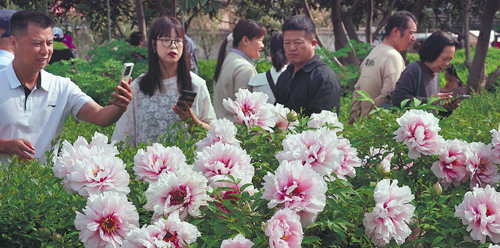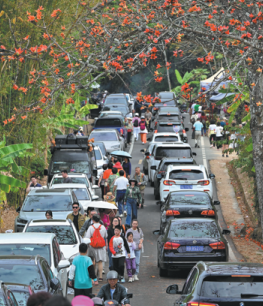Study finds cities choosing similar official flowers

Selections for representative flora don't reflect country's rich biodiversity
Though many mightn't know the official flower of their city, educated guesses might go as follows: In northern China, the Chinese rose flower or syringa. In southern China, azalea, bougainvillea or camellia. Chances are these guesses would be correct.
A recent study of the official flowers and trees chosen by cities across the mainland has revealed many are opting for similar choices.
For instance, out of 270 cities that have designated a city flower, 57 chose the Chinese rose. Similarly, among 256 cities that selected a city tree, 58 chose the camphor tree.
Published in People and Nature, the study, "The homogenization of China's city flowers and city trees", by researchers from the College of Life and Environmental Sciences at Minzu University of China, provided a comprehensive analysis of the current state of city flowers and trees across the country.
City flowers and trees serve as unique symbols that represent the cultural and ecological identity of modern cities, said Long Chunlin, the study's corresponding author, in an interview with China Daily. These plants are not just ornamental, but also play a crucial role in enhancing urban environments and promoting local green industries.
"China is one of the world's most biodiverse countries," Long said. "Yet, we found that the current choices of city flowers and trees do not fully reflect this extraordinary richness."
According to the study, Long said, 270 cities on the Chinese mainland have designated city flowers, with 51 cities choosing two species. Meanwhile, 256 cities have selected city trees, with 30 cities opting for dual species.
Cities without designated flowers or trees are primarily located in western China, suggesting a correlation between economic development, population size and the selection of these botanical symbols.
"City flowers and trees not only represent a city's unique cultural landscape and spiritual character but also embody the harmony between humans and nature," Long said. "They deepen people's love for nature and their hometowns, promote green industries, and enhance urban ecological environments, reputation and competitiveness."
He gave the example of the Bauhinia flower. Also known as the Hong Kong orchid tree, it was designated as the city flower of Hong Kong in 1965. Hong Kong has issued several themed stamps featuring the flower, and its image is prominently displayed on Hong Kong currency.
In 1997, when Hong Kong returned to the motherland, the Bauhinia flower stood out among other symbols such as the dragon and the Pearl of the Orient, becoming the emblem on the Hong Kong regional flag.
Popular choices
The study revealed that the most popular city flowers include the Chinese rose, azalea, osmanthus, common crape myrtle, bougainvillea, lotus, camellias, chrysanthemum, rose and lilac.
Among them, the Chinese rose flower is the most widely adopted, chosen by 57 cities. Azalea and osmanthus follow, selected by 21 and 20 cities, respectively.
These choices exhibit a "spatial clustering pattern", Long said, with northern cities favoring the Chinese rose and syringa, cities in Central China preferring osmanthus, common crape myrtle and lotus, and southern cities leaning toward azalea, bougainvillea and camellia.
Although over 75 plant species have been selected as city flowers, he said, the top 10 most popular flowers account for two-thirds of cities that have designated a city flower.
Similarly, the most common city trees include the camphor tree, pagoda tree, ginkgo, osmanthus, weeping willow, cedar, flame tree, southern magnolia, London plane tree and Chinese pine.
Camphor trees lead the list, chosen by 58 cities, followed by pagoda trees (44 cities) and ginkgo (20 cities). Northern cities favor the pagoda tree, weeping willow and cedar, while central and southern cities prefer southern magnolia, ginkgo, camphor tree and flame tree.
Similar to city flowers, over 94 species have been selected as city trees, but the choices are concentrated on a few species. The top 10 most popular trees account for 60.5 percent of all cities that have designated a city tree.
Long emphasized that city flowers and trees should reflect local biodiversity and cultural heritage, rather than relying on a narrow range of species.
The study found that cultural significance (52.6 percent) and aesthetic value (44.8 percent) were the primary reasons for selecting city flowers, while aesthetic value (39.1 percent) and cultural significance (33.2 percent) dominate city tree choices.
However, a significant portion of cities — 20.4 percent for flowers and 26.6 percent for trees — could not provide clear reasons for their selections, indicating a lack of thoughtful consideration.
Future selections
To address the issue of homogenization, the researchers offered several recommendations for cities yet to designate city flowers and trees.
Long suggested the selection be based on local biodiversity and ecological conditions, favoring native species.
"Some cities choose exotic species that do not suit the local environment," he said.
For instance, Western azalea, while beautiful and easy to acquire, is an introduced cultivar and not suitable as a city flower.
"Similarly, cosmos flower, mistakenly called 'Gesang flower' — a flower popular in Tibetan folklore — is actually an invasive species originating from Mesoamerica," he said.
He also emphasized respecting local cultural traditions and the collective memory associated with specific plants. For example, Luoyang is historically known for Chinese peony cultivation, making it an appropriate city flower.
"However, plants like the plum blossom, which hold special cultural significance across many regions in China, should not be universally selected as city flowers," he added.
The study also emphasized the importance of public participation and expert input in the selection process. Beyond consulting cultural, landscaping and artistic communities, cities should seek advice from biodiversity experts and involve residents to ensure the chosen species resonate with the communities.
The researchers' distribution maps of city flowers and trees reveal a clear divide along the Hu Line, reflecting China's uneven socioeconomic development.
Also known as the Heihe-Tengchong Line, the Hu Line is an imaginary line drawn by Chinese geographer Hu Huanyong in 1935. It stretches diagonally across China from the city of Heihe, in the northeastern province of Heilongjiang, to the city of Tengchong in the southwestern province of Yunnan. The significance of the Hu Line lies in its demarcation of the population distribution in China.
East of the Hu Line, the land is more densely populated and includes major cities such as Beijing, Shanghai and Guangzhou in Guangdong province. This eastern region contains about 94 percent of China's population, despite covering only around 43 of the country's land area. In contrast, the vast region west of the Hu Line, which includes the Qinghai-Tibet Plateau and the Xinjiang Uygur autonomous region, is sparsely populated, accounting for only about 6 percent of the population but covering 57 percent of the land area.
Most of the cities without city flowers and trees are west of the Hu Line.
"Only when a city reaches a certain level of economic development do its residents begin to prioritize quality-of-life considerations, such as selecting city flowers and trees," Long explained. "This makes our research particularly valuable, as many Chinese cities have yet to make their choices and can make better choices."
chenliang@chinadaily.com.cn























